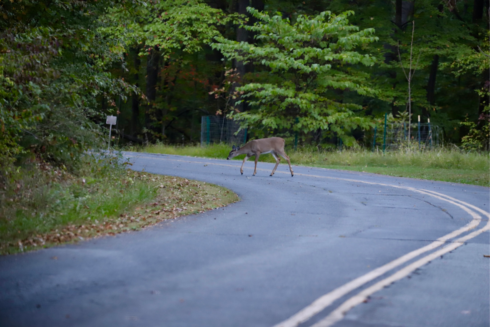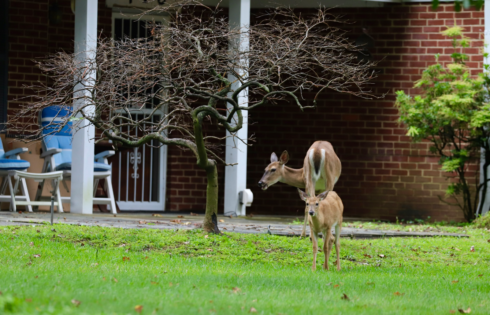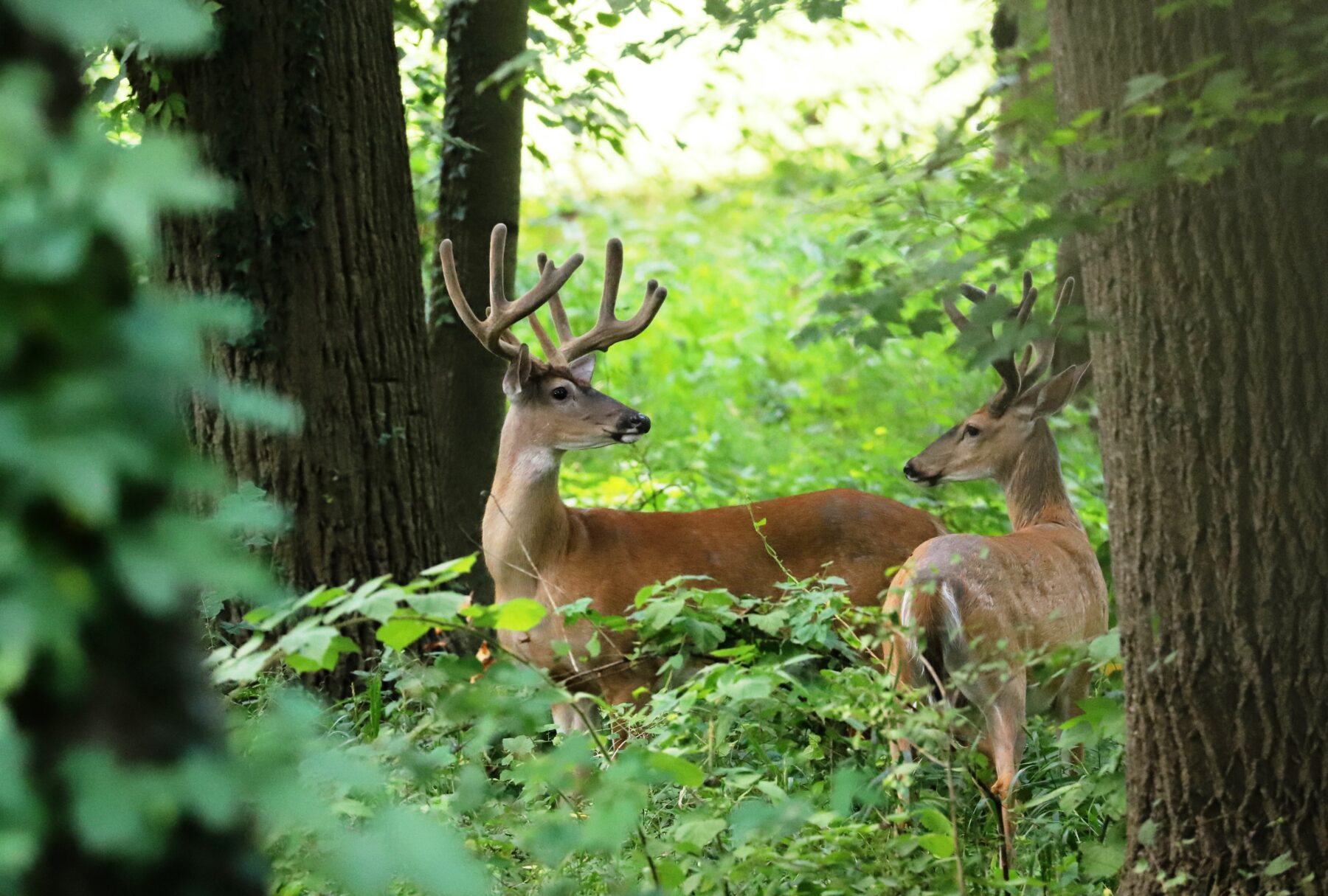Living with White-tailed Deer
Montgomery County’s patchwork of natural areas, agriculture, and landscaped suburban properties provides ideal deer habitat. Deer populations have increased dramatically in recent decades, a result of many variables of land use and social changes.
Continued development and human population growth, as well as the proliferation of “edge” habitat, provides abundant food and cover and sometimes concentrates deer into small areas resulting in increased deer-human conflicts. Conflicts include: deer-related automobile accidents, damage to agricultural crops and residential gardens/landscaping, impacts to forests and other natural vegetation, and threat of communicable disease. Deer Management efforts are underway on parklands to reduce these negative impacts associated with overabundant deer populations. Montgomery Parks is committed to working toward a balance between deer and human priorities and land uses.
Automobiles and Deer
Deer Vehicle Collisions (DVC’s) represent a serious public safety hazard for motorists on Montgomery County roadways. This threat is intensified, due to very high densities of both deer and vehicular traffic, as well as, the prevalence of greenspace located in close proximity to roadways.
Deer will remain a part of Montgomery County’s natural areas and we must learn to live with them to the best of our abilities. Below are some ways to help reduce and prevent problems with deer.
Continued implementation of Montgomery County’s Deer Management Plan helps reduce deer-human conflicts, including DVC’s but will never eliminate them. For more information visit: Maryland Dept. of Natural Resources.
Driving in Deer Country
The most important way drivers can reduce the chances of an accident with a deer is to drive within the speed limit. At night, reduce speeds below the limit, especially in rain, snow, or fog. Other precautions include: scanning the roadside and surrounding areas for deer, and other threats, to try and predict the possibilities of such a hazard.
- Deer are most active at dawn and dusk but remain very active throughout the night.
- Watch for deer where roads pass through wooded or rural areas.
- Deer crossing signs indicate areas where deer vehicle accidents have been known to commonly occur.
- Slow down and watch for the eye-shine of deer near the road edges.
- Be especially cautious during seasons of high deer activity especially – October to January during the breeding season, and May and June when does are birthing and raising fawns, and yearlings are dispersing.
- Deer often travel in groups. Expect this and if you see a deer cross the road, slow down and use caution. More are likely to follow.
What do I do if a deer suddenly jumps in front of my car?

Of course, every case is different, but it is important to remember is to maintain control of your vehicle. Apply the brakes in a controlled manner, and avoid sudden, swerving maneuvers.
Deer are quick and agile animals. It is more likely that they will leap out of your path than it is that you will be able to slow down and steer around them. Most serious injuries occur when a driver skids out of control and leave the road or, worse, swerves into oncoming traffic.
Circumstances arise quickly allowing very little time to react. Try to think and plan ahead. When you see a deer crossing sign, think about what you would do if you suddenly see a deer jump into the road. Mentally practice keeping a cool head and reacting in a controlled fashion. If it should happen one day you will be more prepared to react appropriately.
Damage Control: At Risk Crops, Gardens and Natural Areas
Excluding deer, by means of fencing and similar measures, is the most effective means of preventing damage to agricultural and private landscapes. Additional prevention alternatives for farmers and homeowners include mechanical noise-producing devices, chemical repellents, and selecting plantings that are not favored by deer (a list is available from the sources shown below). Landowners can also open their land to hunters with intent to reduce the number of deer on their property. To make a measurable difference on farmlands, the harvest of antlerless deer, especially mature does, must be the standard.
Citizens can report deer-related problems by calling the Natural Resources Stewardship Section at 301-962-1344. This information is used to better understand trends related to areas of highest impact/concern. While immediate solutions may not be available, these reports can help guide future management decisions on parkland. Information regarding techniques for preventing and/or reducing deer damage on your private property is available through the Montgomery County Cooperative Extension Service at 301-590-9650 or the Nuisance Animal Information line at 877-463-6497 (Maryland Residents Only).
In natural areas such as forest lands and meadows, understory and ground cover composition can be severely impacted by deer. This is because white-tailed deer are plant eaters (herbivores) and feed primarily on leaves, buds, and twigs. Other foods include acorns, other nuts, fruits, clovers, other forbes, grains, and other crops, etc. An average deer eats 6-8 pounds of plants per day or 1 and 1/4 tons per year. An overabundance of deer can have a profound impact on native vegetation and wildlife habitat, home landscape plantings, and agricultural crops. Preferred foods, some of which are rare plants like orchids and lilies, may completely disappear from the landscape. Residents may see many of their favored flowers and shrubs chewed to bare limbs or even to the ground, and farmers may see measurable decreases in crop yields, especially to preferred foods such as soybeans and corn.
In natural areas with extreme deer overpopulation, a “browse line” becomes very evident. Even in mid-summer, there is little vegetation on the forest floor, and the trees and shrubs look as if they have been neatly “clipped” of all leaves up to about five feet. When this happens, young trees are not produced, and habitat for nesting forest-dwelling birds and other wildlife is destroyed. The only way to effectively reduce the negative impacts of deer in landscape level natural areas is to reduce the deer population.

Getting Help: Controlling Deer Damage to Home and Farm Landscapes
Damage prevention alternatives for farmers and homeowners include mechanical noise-producing devices, chemical repellents, and fencing. In addition, homeowners may choose to landscape their property with plants that are not favored by deer (a list is available from the sources shown below). Landowners can/should open their land to hunters to reduce the number of deer on their property. In order to make a measurable difference, hunters must be expected to target, and harvest, antlerless deer, especially mature does. Landowners must help themselves by selecting responsible hunters who will set self-serving interests aside to help achieve the landowner’s goals.
- Information about controlling deer damage on your property is available through the Montgomery County Cooperative Extension Service at 301-590-9650 and through MD Department of Natural Resources.
- The Nuisance Animal Information line at 877-463-6497 (Maryland Residents Only).
- Citizens can report deer-related problems by calling the Natural Resources Stewardship Section at: 301-962-1344 or by emailing Wildlife Ecology & Management Unit.
- Here is a list of deer resistant plants.
Using Deer Fencing to Reduce Deer Damage on Residential Property
An amendment was made to the Montgomery County Zoning Ordinance in 2003 to allow property owners to install “deer fencing” up to 8 feet tall to protect their property from deer impacts. A deer fence, as defined below, can be constructed in any side or back yard as long as there are no community or Homeowner Association restrictions or covenants. On corner lots in residential zones, the side yard fence may not extend farther forward than the front of the house. In addition, an 8-foot fence of any material may be used on lands zoned for agriculture.
Deer Fence: A fence that is up to 8 feet high and constructed of an open mesh ranging in size from 1.5″ x 1.5″ to 2″ x 2.75″ made of heavy weight, plastic, or similar material (not chain link) that allows a clear view through the fence and may be constructed with wood, metal, or fiberglass posts.
Please Note: The installation of any new fence in Montgomery County requires a permit; replacement of an existing fence does not. For more information, contact the Montgomery County Department of Permitting Services (DPS).
Using Archery Hunting to Reduce Deer Populations in Communities
In order to provide more opportunity to manage deer populations within the urban zone, legislation was passed reducing the safety zone for archery hunting (bows and crossbows) in Montgomery County to 50 yards form any occupied structure without written permission (Note: Hunters hunting 50-100 yards of any occupied structure, must be in an elevated position). Archery hunters may hunt anywhere where he/she has written permission of the landowner AND he/she is not within the safety zone of any landowner where such permission has not been granted. It needs to be noted that the discharge of bows and crossbows is not legal within the incorporated municipalities of Gaithersburg and Rockville. This means that, as long as the discharge of bows is legal in a given area, an archery hunter can potentially hunt in a suburban community anywhere he or she has written permission from the landowners(s). Hunters hunting on properties near M-NCPPC Montgomery County parklands should be aware of the Guidelines for Hunters Retrieving Deer from M-NCPPC Parkland (accessible pdf).
Workshops
Part of the County’s Deer Management Plan includes workshops for landowners on how to prevent deer damage around the home. Workshops designed to help citizens cope with deer damage on the landscape is offered free of charge to Homeowner Associations and other community groups. Co-sponsored by the Montgomery County Cooperative Extension Service Master Gardeners and The Maryland-National Capital Park and Planning Commission, damage prevention alternatives for farmers and homeowners include mechanical noise-producing devices, chemical repellents, and fencing. In addition, homeowners may choose to landscape their property with plants that are not favored by deer. For a list of deer resistance native plants, visit the University of Maryland Extension.
Again, landowners concerned about deer impacts can/should open their land to hunters to reduce the number of deer on their property. Focus must be direct to the harvest of antlerless deer first and foremost, especially mature does. Landowners must help themselves by selecting responsible hunters who are willing to help achieve the landowner’s goals. These workshops provide homeowners with the latest information on effective uses of repellents, fencing and vegetation management as well as educational information on other deer impacts and solutions, including hunting.
For information on workshops, call the Montgomery County Cooperative Extension Service at 301-590-9638.
Lyme Disease and Deer
Lyme disease is a bacterial illness transmitted through the bite of the black-legged tick. Early symptoms range from flu-like symptoms, e.g. headache, fever, and general fatigue, to joint and muscle pain. A circular rash, surrounding the bite location, occurs in 70-90% of individuals. If left untreated, the disease can become chronic and debilitating. Lyme disease continues to be a growing concern in the county.
While Lyme disease is often linked to deer management in the mind of the public because it is transferred through the bite of the so-called “deer tick” ( black-legged tick), it is widely accepted that reducing deer numbers cannot effectively control the spread of the disease. Black-legged ticks feed on many species of mammals and birds and most often pick up the disease by feeding on infected mice and other small rodents, not deer. For these reasons, Lyme disease is best viewed as a public health issue. To learn more about Lyme Disease and Ticks, email Wildlife Ecology & Management Unit.
